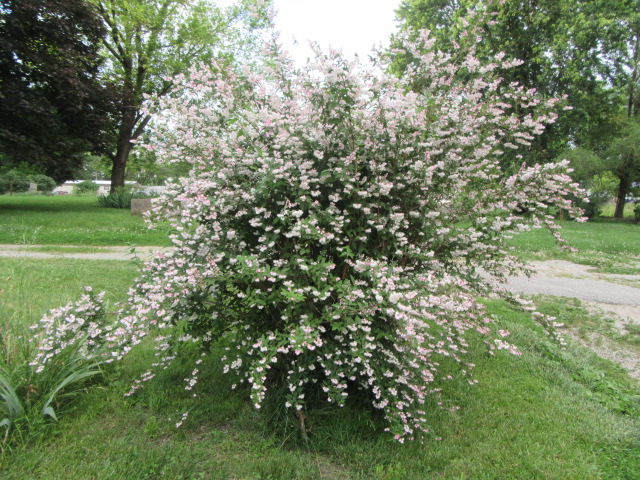
Linnaea (Abelia) x grandiflora on 6-1-19, #580-1.
Hello everyone! I hope this post finds you well. It looks like we are going to have a few days with no rain in the forecast. I have taken quite a few photos over the past week but have been kind of tardy writing posts. Nothing quite as exciting as the Echinopsis mirabilis flower, though. There have been a few surprises, I must admit, which will be in this post… I took a few photos on a friends farm (and along a highway) of a few wildflowers I don’t have here.
I am starting this post with photos I took on June 1 and proceeding through June 8. Some of the photos I took earlier in the week are already out of date and new photos had to be taken throughout the week. Buds become flowers within a few days. 🙂
The Linnaea x grandiflora (syn. Abelia x grandiflora) is flowering up a storm. It was getting very tall so I cut it in half (down to about 5′) in 2017. I am calling this shrub an Abelia x grandiflora, I mean Linnaea x grandiflora, although I am not 100% sure. The photos that “were” on the Missouri Botanic Plant Finder looked like this shrub. Well, I checked again when I made this post and their photos have changed… Hmmm… They are still calling it an Abelia while Plants of the World Online by Kew have changed the name to Linnaea. SO, WHAT IS IT REALLY? The name change wasn’t that recent either!
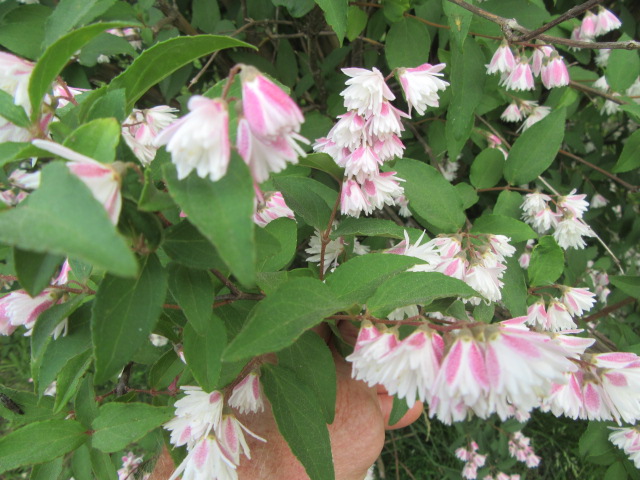
Linnaea x grandiflora flowers on 6-1-19, #580-2.
There are several cultivars of Abelia/Linnaea x grandiflora, but presently, the only flowers online that look the shrub in my yard are the ones from this blog. GEEZ!!! I guess I will have to go further research AGAIN, because now this shrub doesn’t appear to be what I thought it was in the first place… 🙂 On the bright side, if it isn’t an Abelia or Linnaea, I don’t have to worry about wondering which name I am supposed to use. Any ideas?
(My thanks to Jean Molnar for suggesting this shrub may be a Deutzia scabra ‘Plena’. I believe we have a winner! The cultivar name may not be correct because this shrub is likely to be close to 60 years old.)

Catalpa speciosa on 6-1-19, #580-6.
One of my favorite trees is the Catalpa. I love its huge leaves and its beautiful flowers. There are quite a few HUGE Catalpa in town and they are AWESOME this time of the year. I found this tree growing in the old foundation, maybe in 2017, so I removed it and planted it in the yard. It has grown incredibly FAST!

Catalpa speciosa flowers on 6-1-19, #580-7.
Here again, I was presented with a problem. There are two species of Catalpa that are nearly identical, Catalpa speciosa (Northern Catalpa) and Catalpa bignoniodes (Southern Catalpa). Supposedly, Catalpa speciosa has slightly larger leaves and flowers but it hard to tell unless you have both to compare. Both are present in Missouri and their range varies from one website to another. I believe the tree I planted in the yard is the Northern Catalpa because they grow taller than the Southern Catalpa. The larger trees in town easily exceed 60′ tall.

Lysimachia nummularia ‘Goldilocks’ on 6-1-19, #580-10.
Ummm… My first experience with the gold-leaved Creeping Jenny began with my plant friend, Walley Morse, giving me a start in 2010 when I lived at the mansion in Mississippi. I didn’t bring any with me when I left Mississippi in 2013, but I found ‘Goldilocks’ at Lowe’s in 2014. I put in the center of the bed on the north side of the house, which is mostly shaded, as a groundcover. Although the Creeping Jenny does flower, mine did not for all these years. Most of the Creeping Jenny I have seen in people’s flower beds are growing in the shade. As I have mentioned in earlier posts this year, this Creeping Jenny has found the sun. On June 1, as I was staring up the steps, I almost fell because the Creeping Jenny was LOADED with flowers… Strangely, only the plants in the sun have flowers… While gold-leaved plants brighten a shady area, many of them do quite well in full sun. They make a bright area glow even more.
Then on June 3…

Carduus nutans (Musk Thistle) on 6-1-19, #581-2.
I have been spraying and digging the thistles on a friends farm and it has been very interesting. There were so many it was hard to tell which ones I sprayed and which ones I didn’t. Sometimes I knew I sprayed certain groups and they remained alive and well so I sprayed again. Then the next day they would still be perfectly fine. I finally won when I just dug them up. At home, I have the thistles under control and there were only a few this year. When I say “a few” I mean maybe 20 or so. While I have only had a few Musk Thistle here (two a few years ago and two this year in a different location I never had thistles before), my friend’s farm is LOADED with them. It is like a nightmare! I think the thistles here are mainly Bull Thistle, Cirsium vulgare, but several species look so much alike it is hard to tell, especially from photos. I am NOT a fan of spraying, believe me, and I have controlled the thistles here mainly by digging down about 2″ in the soil and cutting their stem. But, when there are HUNDREDS of them, spraying is the best option. I still plan on writing a post about the thistles but I need to make sure I have the correct ID. Sad to say, thistles are beautiful plants with awesome flowers. Ummm… All parts are edible and apparently loaded with vitamins. You can prepare the buds like artichokes. Nope, I haven’t tried it… Nor have I tried artichokes.

Verbascum blattaria f. albiflora (Moth Mullein) on 6-3-19, #581-16.
While working on his farm I noticed these neat flowers growing here and there. They were not growing in colonies, but rather 1-4 spaced several feet apart and only in a couple of areas. I easily identified them later as Verbascum blattaria f. albiflora whose common name is Moth Mullein.

Verbascum blattaria f. albiflora (Moth Mullein) on 6-3-19, #581-17.
There are several colors of Verbascum blattaria, but the f. albiflora is particularly nice.

Penstemon tubaeflorus (White Wand Beardtongue) on 6-3-19, #581-12.
I had been noticing several large groups of flowers along the highway so I got out and took some photos. I later identified them as Penstemon tubaeflorus, commonly known as White Wand Beardtongue.

Penstemon tubaeflorus on 6-3-19, #581-13.
They have particularly interesting flowers with three lower lips and two upper lips with deep throats. The flowers are a pure, glistening white.
I have been keeping an eye on the pink Achillea millefolium I mentioned in an earlier post. Unfortunately, it disappeared. Maybe a cow ate it…
Later in the afternoon…

Amorphophallus sp. on 6-3-19, #581-1.
The Amorphophallus has finally pushed through the soil! I stuck my fingers into the soil a few weeks ago to make sure the two plants in this pot were going to come up. They were slowly working on it… I would really like to know how big their corms are by now but I guess I won’t venture to check.
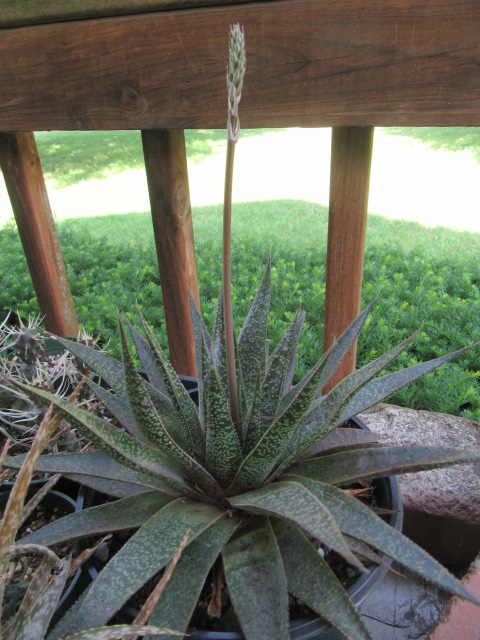
x Gasteraloe ‘Flow’ on 6-3-19, #581-6.
After having the x Gasteraloe ‘Flow’ as a companion since 2016, it is going to flower for the first time. AWESOME!
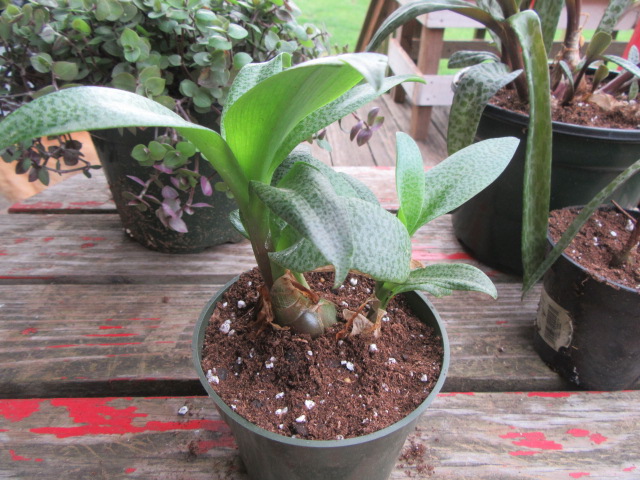
Ledebouria socialis var. pauciflora on 6-4-19, #582-18.
I finally re-arranged the Ledebouria socialis var. pauciflora (Silver Squill) because I was tired of it leaning. This plant is doing very well and SOMEDAY it will start spreading!

Ledebouria socialis var. violacea on 6-4-19, #582-24.
I also re-potted the Ledebouria socialis var. violacea and put it in a larger pot because it is having no problems multiplying. I removed a bulb for a friend in Alabama while I was at it. OUCH! Well, he is sending several new plants that I am trading for a few he doesn’t have. So, I agreed to send him one of these since he is sending a couple cultivars of Ledebouria. Ledebouria are pretty neat plants you may want to give a try and they seem very undemanding.

Achillea millefolium in front of the chicken house on 6-5-19, #583-1.
The Achillea millefolium in front of the chicken house is doing incredibly well this year. They have struggled the past few years because they apparently didn’t have enough sun. I guess all the limbs that fell during the ice storm provided more light for them. They are still inching their way around the corner of the chicken house. The clump I moved in front of the barn last year are doing OK but still haven’t quite gotten with the program. I need to do some research on “older” cultivars that were popular many years ago because this one has been around for a while. My start came from a friend in Mississippi who’s start was given to her by someone else many years earlier. I know it is a cultivar because they grow much different than the Achillea millefolium growing in the pasture and along roadsides.

Group of Alocasia on 6-5-19, #583-3.
The Alocasia are beginning to look much better after a winter in the basement. The biggest Alocasia ‘Calidora’ (on the other side of the barrel) is MUCH taller than I am. Several of the older plants went dormant over the winter and have yet to come to life. GEEZ! Once they go dormant it seems to take a very long time for them to come back to life. Normally, the bigger plants don’t go dormant in the basement over the winter…

Aloe maculata on 6-5-19, # 583-4.
The Aloe maculata is doing very well after being in the house over the winter. I usually keep it in the basement during the winter, but this year I let it stay in the dining room. As you can see, it has several pups that need to be in their own pots. It will start flowering soon. 🙂

Astilbe x arendsii ‘Fanal’ on 6-5-19, #583-5.
The Astilbe x arendsii ‘Fanal’ is strutting its stuff!

Hosta ‘Empress Wu’ on 6-5-19, #583-19.
The Hosta ‘Empress Wu’ is starting to flower…

Hosta ‘Forbidden Fruit’ on 6-5-19, #583-20.
And so is Hosta ‘Forbidden Fruit’. I need to do some work on the shade beds but the mosquitos are crazy there right now.

Equisetum hyemale on 6-5-19, #583-17.
The Horsetail is… Strange how I am at a loss for words. I… Ummm… For the most part I really like the Equisetum hyemale because I don’t ever have to worry about it. It survives and grows no matter what. The only issues are duriing the winter when the cold and wind causes the stems to fall over. Some stand back up, but some do not. Once I get in the mood, I will pull the weeds and grass around and among the Horsetail and cut off the stems laying on the ground. Believe me, there is plenty of new growth, even in the yard 10-15 feet away. But that is no problem for the lawn mower. Nothing distracts the Horsetail’s mission to grow, thrive, and be happy.
The area in front of the chicken house gets neglected quite a lot even though I had plans here originally. The soil is good but the moles work in this area more than I do. The light in this area is also weird. I have put various plants in front of the chicken house over the years and nothing seems to work well. Nothing except for the Horsetail and sometimes the Achillea millefolium at the other corner. I do have a NICE colony of Ajuga reptans ‘Chocolate Chip’ growing along the northeast side that has always done very well, although also neglected.

Malva sylvestris on 6-5-19, #583-22.
When I saw these plants at Wagler’s Greenhouse they were unlabeled. I asked what they were and she said, “she said they were Miniature Hollyhock.” That sounds weird. She didn’t say who “she” was and I didn’t ask. ANYWAY, being unlabeled always gives one side of my brain a red light and the other side a green light. At first the red light wins and I pass by. Then the negotiation between the two sides begins and the green light wins. Yeah, that is a very good way to explain my insanity when it comes to bringing home unlabeled plants. It gives me an opportunity to do research and learn. That can lead to confusion especially when there are several genera in the Malvaceae family that are similar and have similar leaves and flowers. So, you have to wait until they flower. Ummm… The flowers are similar for several genus and species, but fortunately, the flowers of Malva sylvestris are unmistakable. THANK GOODNESS!

Oenothera biennis (Evening Primrose) on 6-5-19, #583-24.
This is another “Ummm…” plant. The Evening Primrose (Oenothera biennis) is a Missouri native (and the rest of central and the eastern part of North America). It somehow thought growing in a crack in the concrete floor would be a good idea (what was the back porch of my grandparent’s old house). I first noticed it when I moved back in 2013, and although I never saw an Evening Primrose, I somehow knew what it was. I didn’t pull it out of the crack so I guess it thought I liked it. Now they come up everywhere they think it is OK along the back of the old foundation.
The Evening Primrose is an interesting plant that only lives for two years. The first year’s leaves grow in a tight rosette and spirally on the stem the second year. The flowers open in the evening and, if you are lucky, last until around noon the following day. I have RARELY seen their flowers… Of course, this is the plant Evening Primrose oil comes from.
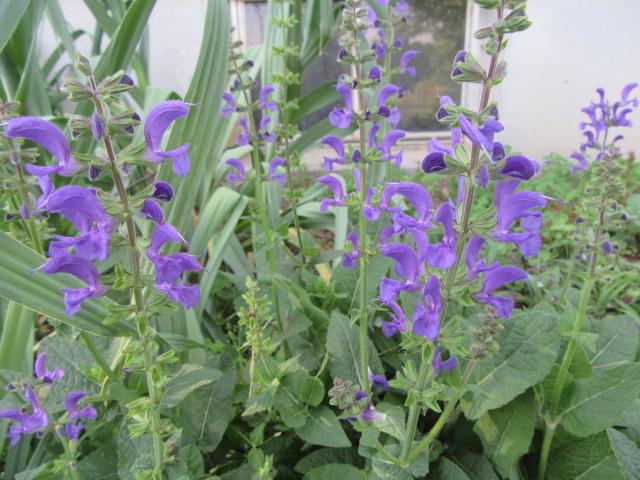
Salvia pratensis ‘Midnight Model’ on 6-5-19, #583-31.
The Salvia pratensis ‘Midnight Model’ is an awesome Salvia. Well, in my book, all Salvia are AWESOME! I deadheaded these two plants on May 19 and they started right back blooming again. Last summer I neglected to deadhead once and they didn’t flower for quite a while. I haven’t made that mistake yet this summer. OH, summer has just begun… 🙂
Then finally on June 8…
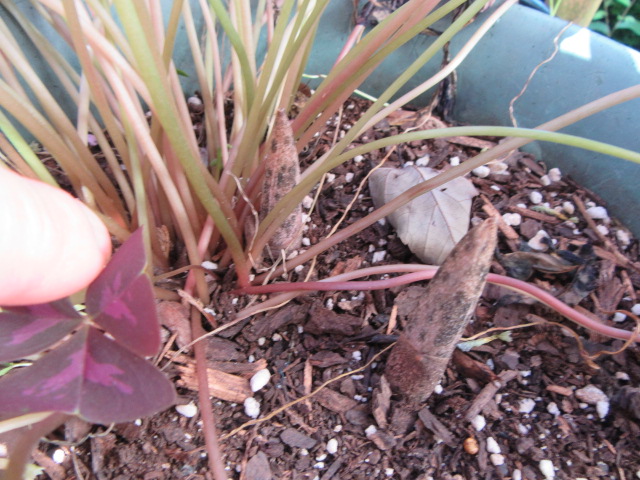
Amorphophallus sp. on 6-8-19, #584-1.
The Dragon’s Tongue, Voodoo Lily, or whatever you choose to call it has tripled in size since June 3. I won’t really know what the species is until they flower, but I suspect Amorphophallus konjac is the likely candidate. Out of 223 accepted species on Plants of the World Online (as of now), there are only a few that are commonly available that would be passed along at a local greenhouse fairly inexpensive. Actually, maybe just one. Well, maybe we can even narrow that down to zero but that would leave me back where I started. Even though Amorphophallus konjac is a common Voodoo Lily, you probably won’t find it at Lowe’s or Wal-Mart.
Passalong plants are plants that reliably come up and multiply. Plants that everyone has but seldom buys. Plants you usually wind up with so many you have no idea what to do with are sometimes considered passalong plants. Plants that are very nice and you like really well that you hate to pull up and throw on the compost pile because you have so many. Then they will start coming up in and around the compost pile. Plants that you would sometimes like to go to another town and leave on people’s doorstep and run away. Never in your own small hometown because their neighbors may recognize you. 🙂 Believe me, the thought has crossed my mind. Passalong plants are great to trade with people at plant swaps because there are always people that come and have no idea what they are getting into.
Moving right along…

Aptenia cordifolia/Mesembryanthemum cordifolium f. variegata on 6-8-19, #584-3.
The Aptenia cordifolium f. variegata, or Mesembryanthemum cordifolium f. variegata, is doing very well. While I am getting used to typing Mesembryanthemum without checking the spelling my computer wants to spell variegata wrong. It seems to think it should be variegate. GEEZ! I am just reluctant to change the name from Aptenia to Mesembryanthemum because I think it will change back again. The neat little flowers are a challenge to photograph because they close in the afternoon before I normally take photos.

Aptenia cordifolia/Mesembryanthemum cordifolium f. variegata on 6-8-19, #584-2.
Ummm… Yes, this is an “ummm” plant. I am not going to say anything else. Just think of the first thing that comes into your mind. Ummm… Now you see what I mean? What are we thinking? This is a plant and how the bud starts!
It is times like this I wonder if the Angels are reading my mind. How does what we think affect our Karma? I am just glad we can use the excuse, “I am just human.” After all, the Creator of the Universe and all the divine beings have a sense of humor and probably are thinking the same thing. Nature can be humorous and this is one of those times.

Ledebouria socialis var. violacea on 6-8-19, #584-6.
Well, isn’t that amazing?!?! I just repotted this plant on June 4 and now it has its first bud. That is, it’s first since I have had it here. I have no idea how old as these bulbs (corms or whatever you call them) are. I am very thankful I get to experience the Silver Squill flowering. I think this will be a WOW moment not because they are rare or seldom flower, but because I have never seen one in person. Supposedly you have to be careful how you overwinter these plants or they won’t flower. You have to ignore the heck out of them and don’t give them any water during the winter months. I had to keep them in a room I seldom went in most of the winter to accomplish this. Once I put them in my bedroom in April, I had to give them a little water. For some reason, and I have no idea why, some consider Ledebouria a succulent. They are very popular plants with succulent enthusiasts, too.
No, I didn’t plan using the last two photos in sequence…
I am almost finished…

Ferocactus wislizeni on 6-8-19, #584-4.
I had a photo in the last post showing the red spines of this Ferocactus wislizeni (Fishhook Barrel Cactus). When I was looking at the cactus on June 8 I noticed something very strange… The “apex” of the cactus is where the new spines are formed… How come there are three now? I didn’t notice this earlier perhaps because of the hot glue stuck in its spines. I am very glad the hot glue slid off when I was taking this photo without doing any damage. 🙂 Anyway, information on Llifle says, Ferrocactus wislizeni is “a barrel-shaped or columnar cactus that stay usually a single column; rare specimens may be multiple…” Hmmm… This cactus is only approximately 1 3/4″ tall and it is already doing weird things… I have only had this cactus as a companion since March 30, so it could get interesting. We shall see…

Mammillaria decipiens on 6-8-19, #584-7.
The always witty Mammillaria decipiens (possibly subsp. camptotricha) is starting to flower again. It freely flowers most of the summer and I am thankful they are white instead of pink. This is a neat cactus!
OK, now I am finished for now.
Until next time, be safe, stay positive, and always be thankful. Get as dirty as you can and enjoy!
You have a lot of plants. And, you know their names. I guess we are all experts at something and know more than most other people about it. Is there anyone to take over your kingdom when you die?
This amused me…”Plants that you would sometimes like to go to another town and leave on people’s doorstep and run away. Never in your own small hometown because their neighbors may recognize you. 🙂 Believe me, the thought has crossed my mind.” You could be the Plant Ninja. We have a guy who comes to our house every friday to collect our bucket of compostables from the kitchen. He silently takes our bucket and gives us a fresh clean one. He is the Compost Ninja.
LikeLiked by 1 person
Hello Jim! The Compost Ninja has a pretty good idea! I am not a plant expert but I do like to know their names. It makes me sound like an expert. 🙂 We all have a talent for sure and we have found ours. I am not going to die, so I don’t need anyone to take over my kingdom. If I happen to disappear and never come home, I am not sure what would happen with the plants. Hopefully whoever moves here will have an interest in them. Thanks for the comment!
LikeLike
Hi Rooster
The (very lovely) shrub you call Abelia x grandiflora has a very different flower from what I have seen of Abelia x glandiflora in England. Now this was my first horticulture tutors favourite shrub so I do tend to take notice of it and to be fair whilst initially I was puzzled by his love for it, this understated do-er has grown on me over time (not literally!) The flowers here are little trumpets very delicate and lots of them all down the stem a pale pink /white, it has smaller more glossy leaves too but it does have an arching habit. Ours flower end of summer into Autumn. Your flowers look bigger and multi petalled? So I know what it isn’t, but not what it is! – Not too much help I guess!
I can’t believe that lovely white penstemon is growing wild and the verbascum is really pretty and very similar to one I have grown from seed in my top border where it is a bit of a thug but I do like it never the less. My Achillea moonshine are looking fab btw and thanks for a lovely long post. 🙂
LikeLiked by 1 person
Hello Debbie! I am not sure what it is, but I have ventured away from what I thought it was. Strange how I correctly identified it mainly from the Missouri Botanic Garden website and now their photo is different! Where before there were many photos online similar to it, now there are none! Now they are trumpet-like flowers that seem to grow in clusters. The flowers are fairly small, but they are like double-petaled (at least). The bush is more of an upright frower instead or arching. Time to put your training to use, Pixiedeb. 🙂
It was great to see the lovely Verbascum in the wild. Such a treat and blessing to make the discovery. I am thinking about bringing a few home, or at least collect seed. I am happy to hear your Achillea ‘Moonshine is doing well as is mine.
My posts are a bit lengthy and I am glad you enjoyed it. Thanks for the comment!
LikeLike
Great selection. Is your Amorphophallus likely to flower this year? Also is your ‘Abelia/Linnaea x grandiflora’ possibly a Deutzia … like Deutzia scabra ‘Plena’?
LikeLiked by 1 person
Hello Allison! Unfortunately, the Amorphophallus is not ready to flower AGAIN this year. They usually flower before the leaves emerge. I think you are right about the bush being a Deutzia scabra. Thanks for the comment and steering me in the right direction.
LikeLike
Thanks for sharing . You do encourage me to pursue my enjoyment of gardening . Sometimes I become discouraged but your post picks me back up .
LikeLiked by 1 person
Hello Jean! I know what you mean about being discouraged sometimes. Sometimes it isn’t easy, especially when you are doing it all yourself. The weeds, moles, watering, mosquitos, deadheading, the heat… But the variety we can grow and finding out what does well and looks great makes it worth the effort. Sometimes we find plants that seem to speak to us and there are some that completely ignore us. I am happy my posts brings you encouragement. Thanks for the great comment!
LikeLike
I don’t know why but it always amazes me how you know all the names for the plants and you know how to take care of them, you’re so good with them. I’m not sure which is my favorite here, maybe the Salvia pratensis ‘Midnight Model’ maybe the deep pink ones, but than again I love cacti also, so I’ll just say i like all of them. Thank you.
LikeLiked by 1 person
Hello Masha! The Salvia pratensis ‘Midnight Model’ is a really nice Salvia. It does very well and puts on a great show of unique flowers. I don’t really have any particular favorites because that would be like having a favorite child. But, like children, some just require more attention. Cactus are awesome and will surprise you at times. Learning plant names became a challenge many years ago. I make it a goal to know their common names and scientific names. Keeping up with name changes has been very interesting as some have changed several times. Sometimes it is a while before I even know they change. Thanks for the comment!
LikeLiked by 1 person
I am in awe of your command of Latin names, and your capacity to keep up with the name changes. Impressive skills, and impressive plants!
LikeLiked by 1 person
Hello Simon! When I update plant pages I automatically check to see if their names are the same or if they have changed. Sometimes I get surprised. Most plants are impressive in one way or another. Thanks for the comment!
LikeLiked by 1 person
🙂 I also meant to say that I avoid spraying in the garden buy using a gas powered flame gun. It may not be practical for you but it clears paving and gravel equally as well as a spray but without the chemicals. Have used it on thistles in flower beds but not used it in fields.
LikeLiked by 1 person
That’s a good idea in certain situations. I’m not sure how practical or safe it would be in a very large pasture where there are hundreds of thistles, grass, debris from hay, etc. where a fire could get out of control. I bet it would be great for brick sidewalks, though. I try to avoid using chemicals if at all possible.
LikeLiked by 1 person
I once burned 10 acres when a small rubbish fire got out of control, so I appreciate your concerns. 🙂
LikeLiked by 1 person
YIKES!
LikeLiked by 1 person
It taught me a lesson about dry grass and fire.
LikeLiked by 1 person
I can imagine.
LikeLiked by 1 person